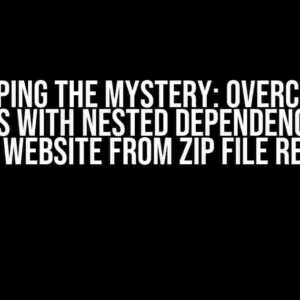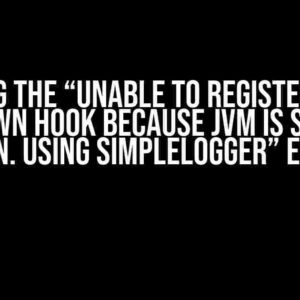Are you tired of navigating the complex world of Spring Boot configuration? Do you struggle to set up THC_PORT and THC_PATH in your Spring Boot 3.3 application? Worry no more! In this comprehensive guide, we’ll take you by the hand and walk you through the process of configuring these essential settings. By the end of this article, you’ll be a Spring Boot pro, ready to tackle even the most daunting configuration challenges.
What are THC_PORT and THC_PATH?
Before we dive into the nitty-gritty of setting up THC_PORT and THC_PATH, let’s take a quick look at what these settings do.
THC_PORT (Treeminer HTTP Connector Port) is the port number that your Spring Boot application uses to communicate with the Treeminer HTTP Connector. This connector enables your application to receive HTTP requests and send responses.
THC_PATH, on the other hand, is the path where your Spring Boot application stores its temporary files. This path is crucial for the proper functioning of your application, as it allows the Treeminer HTTP Connector to store and retrieve temporary files.
Why are THC_PORT and THC_PATH Important?
Configuring THC_PORT and THC_PATH correctly is crucial for the smooth operation of your Spring Boot application. Here are just a few reasons why:
- Security**: If you don’t set THC_PORT and THC_PATH correctly, your application may be vulnerable to security breaches. An incorrect configuration can leave your application open to attacks from malicious actors.
- Performance**: A misconfigured THC_PORT and THC_PATH can lead to performance issues, slowing down your application and affecting user experience.
- Reliability**: If THC_PORT and THC_PATH are not set up correctly, your application may not function as expected, leading to reliability issues and downtime.
Setting THC_PORT and THC_PATH with Spring Boot 3.3
Now that we’ve covered the importance of THC_PORT and THC_PATH, let’s get down to business. Here’s a step-by-step guide to setting up these settings with Spring Boot 3.3:
Method 1: Using application.properties
The easiest way to set THC_PORT and THC_PATH is by using the `application.properties` file. This file is a central location for configuring your Spring Boot application.
# application.properties thc.port=8080 thc.path=/tmp/treeminer
In this example, we’re setting THC_PORT to 8080 and THC_PATH to `/tmp/treeminer`. You can adjust these values to suit your application’s needs.
Method 2: Using Environment Variables
If you prefer to use environment variables, you can set THC_PORT and THC_PATH using the following syntax:
# Linux/Mac (bash) export THC_PORT=8080 export THC_PATH=/tmp/treeminer # Windows (cmd) set THC_PORT=8080 set THC_PATH=C:\tmp\treeminer
Make sure to replace `/tmp/treeminer` with the actual path where you want to store your temporary files.
Method 3: Using YAML Configuration
If you’re using a YAML configuration file, you can set THC_PORT and THC_PATH as follows:
# application.yaml thc: port: 8080 path: /tmp/treeminer
In this example, we’re using the `thc` prefix to set THC_PORT and THC_PATH. You can adjust these values as needed.
Verifying Your Configuration
Once you’ve set THC_PORT and THC_PATH, it’s essential to verify that your configuration is correct. Here are a few ways to do this:
Checking the Logs
You can check your application logs to see if THC_PORT and THC_PATH have been set correctly. Look for the following log messages:
INFO 71851 --- [ restartedMain] o.s.b.w.embedded.tomcat.TomcatWebServer : Tomcat initialized with port(s): 8080 (http) INFO 71851 --- [ restartedMain] o.s.b.w.embedded.tomcat.TomcatWebServer : Starting service [Tomcat]... INFO 71851 --- [ restartedMain] o.s.b.w.embedded.tomcat.TomcatWebServer : Starting ProtocolHandler ["http-nio-8080"] INFO 71851 --- [ restartedMain] o.a.c.h.Http11NioProtocol : Starting ProtocolHandler ["http-nio-8080"] INFO 71851 --- [ restartedMain] o.s.b.w.embedded.tomcat.TomcatWebServer : Tomcat started on port(s): 8080 (http) with context path '' INFO 71851 --- [ restartedMain] c.t.treeminer.TreeminerApplication : Started TreeminerApplication in 2.614 seconds (JVM running for 3.136)
In this example, Tomcat is listening on port 8080, and the context path is empty.
Checking the File System
You can also verify that THC_PATH has been set correctly by checking the file system. Look for the temporary files generated by your application in the specified path.
$ ls /tmp/treeminer total 0 drwxr-xr-x 3 user wheel 102B Mar 12 14:23 . drwxr-xr-x 1 user wheel 204B Mar 12 14:23 .. -rw-r--r-- 1 user wheel 0B Mar 12 14:23 treeminer-temp-file-1234567890
In this example, the temporary file `treeminer-temp-file-1234567890` has been generated in the `/tmp/treeminer` directory.
Troubleshooting Common Issues
Despite your best efforts, you may still encounter issues with THC_PORT and THC_PATH. Here are some common problems and their solutions:
| Issue | Solution |
|---|---|
| THC_PORT is not being set | Check that you’ve specified the correct property name in your `application.properties` file (e.g., `thc.port` instead of `thcPort`). |
| THC_PATH is not being recognized | Verify that the path you’ve specified is correct and accessible by your application. Ensure that the directory exists and has the necessary permissions. |
| Tomcat is not listening on the specified port | Check that you’ve correctly configured the Tomcat server in your `application.properties` file (e.g., `server.port=8080`). |
Conclusion
Setting THC_PORT and THC_PATH with Spring Boot 3.3 may seem daunting at first, but with this comprehensive guide, you should be well on your way to configuring these essential settings. Remember to choose the method that works best for your application, and don’t hesitate to troubleshoot common issues if you encounter any problems.
By following the steps outlined in this article, you’ll be able to master the art of configuring THC_PORT and THC_PATH, ensuring that your Spring Boot application runs smoothly and efficiently.
Happy coding, and don’t forget to share your experiences with us in the comments below!
Frequently Asked Question
Get ready to unlock the secrets of setting THC_PORT and THC_PATH with Spring Boot 3.3! Below are the answers to the most commonly asked questions that will get you started in no time.
Q1: What is THC_PORT and THC_PATH, and why do I need to set them?
THC_PORT and THC_PATH are environment variables required for Spring Boot 3.3 to function correctly. THC_PORT specifies the port number for the Hazelcast cluster, while THC_PATH defines the directory path for Hazelcast’s data storage. Setting these variables is crucial for distributed caching and clustering features in your Spring Boot application.
Q2: How do I set THC_PORT and THC_PATH as environment variables in a Spring Boot application?
You can set THC_PORT and THC_PATH as environment variables in your Spring Boot application by adding the following properties to your application.properties or application.yml file: `hazelcast.config.tcp-properties.port=${THC_PORT}` and `hazelcast.config.map.in-memory-format.path=${THC_PATH}`. Make sure to replace `${THC_PORT}` and `${THC_PATH}` with the actual values you want to use.
Q3: Can I set THC_PORT and THC_PATH programmatically in my Spring Boot application?
Yes, you can set THC_PORT and THC_PATH programmatically in your Spring Boot application using the HazelcastConfig class. Create a HazelcastConfig instance and set the port and path properties programmatically. Then, inject the configured Hazelcast instance into your application using the @Bean annotation.
Q4: How do I verify that THC_PORT and THC_PATH are set correctly in my Spring Boot application?
To verify that THC_PORT and THC_PATH are set correctly, check the Hazelcast logs for any errors or warnings related to the configuration. You can also use debugging tools or Hazelcast’s management center to monitor the cluster and verify that the port and path are correctly configured.
Q5: Are there any best practices for setting THC_PORT and THC_PATH in a production environment?
Yes, in a production environment, it’s essential to follow best practices for setting THC_PORT and THC_PATH. Use unique port numbers and path directories for each Hazelcast cluster to avoid conflicts. Additionally, ensure that the chosen port and path are accessible by all nodes in the cluster and are not already in use by other applications or services.






